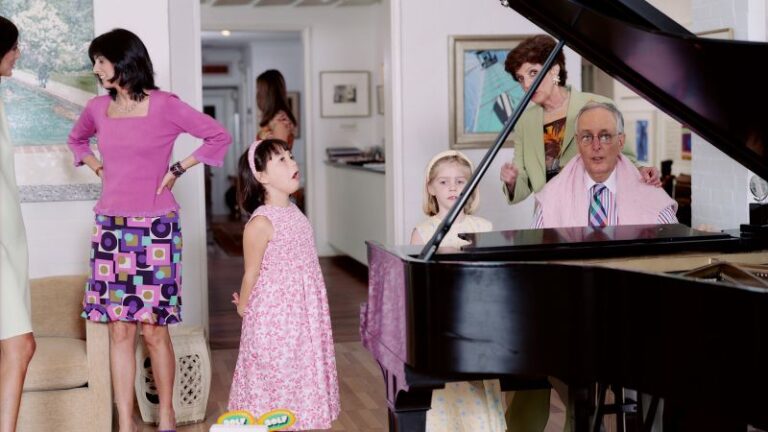London
—
Throughout the 20th century, fashion shoots took place almost exclusively in an indoor photography studio, or in a public space like a bustling city street. But nowadays, you are just as likely to see a campaign or magazine shoot staged in someone’s bedroom, lounge or kitchen, alongside their personal possessions. The shift is the focus of a new book, “The Domestic Stage: When Fashion Image Comes Home,” which explores photographers’ fascination with the home and why brands prefer the intimate setting.
When the pandemic struck in 2020, the book’s author Adam Murray — a writer, curator and pathway leader for the MA Fashion Image course at London’s art and design college Central Saint Martins — observed how young photographers and image makers were forced to adapt during lockdowns. Many began shooting at home because it was the only location available to them. “I was impressed by how resiliently they worked and how creative they were within the restrictions,” he said in an interview with CNN.

Emerging photographers weren’t the only ones who had to adapt during this period. Fashion brands including Zara, Martine Rose, Jacquemus and Gucci, as well as publications such as i-D and Vogue Italia, asked models to shoot themselves at home for campaigns, magazine editorials, and even virtual runway shows. For Murray, it marked a “turning point” for fashion photography. Images could now be captured or created outside of a professional studio and still be seen as “equally valid,” he said.
While lockdowns and other social distancing measures have since lifted, intimate, private settings remain a popular choice of location for fashion photographers, said Murray. The change, he believes, coincides with a shift in fashion marketing from unattainable glamour to focusing on relatability and authenticity through everyday moments and normalizing flaws. The rise of reality TV shows such as “Keeping Up with the Kardashians,” which offers a seemingly unvarnished glimpse into the privileged lives and interpersonal relationships of the wealthy family, has also contributed to a desire, particularly among young people, for “real” and genuine images over ones that feel overly curated.
“I think there is this urge from audiences for a world beyond the super constructed artifice that we usually associate with fashion,” said Murray.
Most of the houses featured in “The Domestic Stage” belong to the people being photographed — typically street-cast models or the photographer’s own family and friends — or were rented holiday homes. However, it means doing away with a lot of the commotion that accompanies a typical shoot, simply because most domestic spaces can’t accommodate it. Gone are the armies of assistants and trucks filled with clothing, or the crowds of onlookers hoping to catch a glimpse of a top model. In their place is a more curated selection of outfits and one or two crew members on set. In this sense, homes offer a more private and personal environment, which can be comfortable and creatively stimulating.
That’s not to say that domestic spaces are predictable. The book features stories of photographers working with mischievous children, incorporating surprise visitors into pictures, and resorting to flashlights due to power cuts. The unexpected environments lend the images some realism; in the book, the London-based photographer Joyce Ng describes her experience on a shoot for the fashion publication 1 Granary, which involved navigating a household of six children, as “the epitome of beautiful chaos”. Other photographers featured said they drew inspiration from people’s living spaces, preferring to leave them untouched and treating them as an extension of the person they are photographing.
Though, some projects still require intense preparation, particularly when large brands are involved. For example, Dior’s Fall-Winter 2024 campaign shot by Sarah Jones involved working with a set designer to visualize and dress the rooms of an abandoned French chateau, resulting in highly manicured scenes. That same year, the Italian luxury label Bottega Veneta produced a campaign reinterpreting Carrie Mae Weems’s influential photography projects “Kitchen Table Series” (1990) and “Family Pictures and Stories” (1981-1982), this time starring A$AP Rocky and his children and using carefully planned props and set design.

The Bottega Veneta campaign was striking not only because of the iconicity of Weems’s original series but also because of the air of familiarity it created around both A$AP Rocky and, by extension, the brand. At a time where authenticity is touted by marketers as a way for brands to engage deeply with audiences, domestic spaces, with their “intimacy and imperfections,” are especially desirable, Murray explained. “Even though a lot of the work is as constructed as something would be in the studio, it’s got a bit more of a sense of reality to it,” he said.
Some photographers flip this assumed authenticity on its head by reverse-engineering studios and sets to resemble homes.

The London-based photographer and filmmaker Rachel Fleminger Hudson designs the sets in her editorials to look like kitchens, bedrooms and lounges — albeit with an intentionally synthetic feel, akin to the setting of a stage play rather than a real home, to highlight how people construct and perform their everyday lives. Elsewhere, magazine spreads published by Vogue Hommes International show how domestic spaces have an element of artificiality, as seen in the photographer Nigel Shafran’s images of soccer stars in their barely lived-in temporary homes, or visual artist Sarah Jones’s uncanny series picturing show apartments. “She’s very interested in this idea of how these spaces create aspirations,” Murray said of Jones’s work, noting it explores personal ideals when it comes to the kinds of homes one might desire and seek to build.
As boundaries between the public and private continue to dissolve in the always-on era of social media, shooting in people’s homes has come far from being a quirk of the pandemic era and domestic spaces are set to remain a common feature in fashion imagery. “This wasn’t just a couple of years where everyone was doing it — this is an ongoing thing,” Murray said.
“The Domestic Stage,” published by Thames & Hudson, is available in the UK now and the US on October 7.




